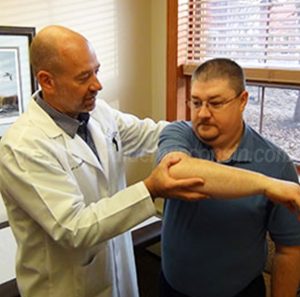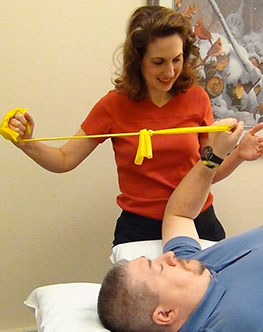At Hand to Shoulder Center of Wisconsin, our orthopedic staff understands shoulder pain and how important the right treatment can be for our patients. From helping you understand the shoulder to understanding shoulder pain and all treatment options, both surgical and non-surgical, let our team help. Contact the orthopedic team at Hand to Shoulder Center of Wisconsin to see how we can help you.
The shoulder is constructed of three bones; the humerus (upper arm bone), scapula (shoulder blade), and the clavicle (collar bone). The shoulder region itself contains several joints, muscles, tendons, and ligaments allowing the arm great mobility. For this reason, the shoulder is the most mobile joint in the body, making it vulnerable to common injuries and problems.
The shoulder joint (ball and socket) is surrounded by a group of four tendons and muscles commonly known as the rotator cuff. When the rotator cuff is involved in an injury, the pain can arise from the tear of the tendons or muscles surrounding the rotator cuff. Mild to excruciating pain may be felt. The pain may be felt in localized areas of the shoulder joint itself; however, more commonly the pain can travel down to the outside of the upper arm and even into the elbow area (Gerber, 1998). Weakness in lifting, reaching, and overhead activities may become painful and difficult.
Shoulder injuries can be caused by an acute (traumatic) injury or gradual (chronic) onset of pain in the shoulder region. Common shoulder injuries can occurs during sporting activities, manual labor, or can be brought on by the natural age-related degeneration of the surrounding soft tissues in the shoulder region.
Common causes of shoulder pain include but are not limited to:
- Shoulder impingement
- Rotator cuff disease: tendinitis and bursitis
- Rotator cuff tear
- Frozen shoulder
- Shoulder dislocation
- Shoulder separation
- Shoulder fracture
- Arthritis of the shoulder
Shoulder Pain: Surgical & Non-Surgical Treatment Options

Figure 1: A shoulder assessment is performed by Dr. Jon J. Cherney
At Hand to Shoulder Center of Wisconsin, a thorough medical examination is conducted by a hand and upper extremity (wrist, elbow, and shoulder) fellowship-trained orthopedic physician (Fig. 1). Upon evaluation the physician explores prior shoulder and arm injuries, genetic medical conditions along with how the shoulders have been used. The examination includes an assessment of the shoulder and arm mobility as well as strength to determine the status of the rotator cuff and shoulder blade muscles. X-rays can be ordered to determine if arthritis is a factor or to detect any previous or present fracture conditions. An MRI (magnetic resonance imaging) is sometimes ordered to further evaluate the muscles and ligaments around the shoulder. This is not always ordered on the initial visit, but often after a course of physical or occupational therapy.
MRI testing allows for a clear image and assists in determining if the soft tissues in the shoulder region have been exposed to an injury or chronic damage. Inflammation and fluid levels are reviewed and recorded.
It is the goal of our physicians to alleviate pain and restore shoulder function with conservative treatments as the first option.

Figure 2: A licensed therapist instructs a shoulder treatment exercise
In non-surgical shoulder cases, rest, activity modification, and restrictions from overhead lifting may be discussed. Anti-inflammatory medications such as ibuprofen, naproxen, and/or icing may reduce and help control swelling. Physical or occupational therapy is often ordered as part of the treatment plan with a qualified hand and upper extremity therapist. The therapist will work directly with you to help correct poor biomechanics and improve the strength and flexibility of the entire shoulder region (Fig. 2). Patients are given home exercises to further improve their strength and mobility to achieve their goals. Other non-surgical treatment can include a steroid injection. This involves a local anesthetic and cortisone injection injected into the shoulder region to help control inflammation. This can be especially beneficial for patients with bursitis or rotator cuff involvement.
In surgical shoulder cases, the severity of the injury or condition will determine if the surgery is an outpatient or inpatient procedure. Arthroscopic shoulder surgeries (shoulder arthroscopy) is a procedure using a scope by our experienced shoulder surgeons. Two or three small incisions are made allowing the surgeon to insert a fiberoptic scope into the problem area. The fiberoptic scope is connected to a video monitor allowing the surgeon to guide small instruments into the damaged area. Evaluation is done and the needed repairs are made. Arthroscopic debridement (shoulder debridement) or removal of damaged tissue and smoothing out roughened areas of bone may be done at this time, if needed.
Open surgical techniques are typically preformed in more complex shoulder cases. Shoulder fracture, shoulder dislocation or shoulder separation, total shoulder joint replacement, and reverse total shoulder replacement are a few examples when open surgery techniques may be recommended for better results.
Following surgery, whether arthroscopic or open surgery, our experienced shoulder surgeons work closely with our skilled shoulder therapists to design a rehabilitation program to regain range of motion of the shoulder and strengthen the arm. Recovery time varies but typically it takes 2 to 4 months to achieve pain-free status however it can take up to a year.
In surgical cases performed by the orthopedic surgeons at Hand to Shoulder Center of Wisconsin, insurance benefits are verified and referrals and precertification are acquired if required. Our surgeons perform surgery at Woodland Surgery Center, adjacent to Hand to Shoulder Center of Wisconsin, in Appleton, and have surgical privileges at all three local Fox Valley hospitals.